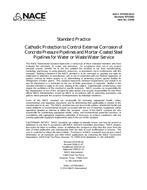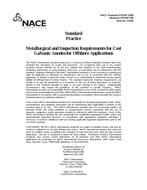
NACE SP0100-2014
Click here to purchase
Concrete and steel are considered compatible materials because they have similar coefficients of thermal expansion and because concrete usually provides steel with excellent corrosion protection. Because of the high alkalinity of portland cement, a stable, corrosion-mitigating, passive oxide film forms on the surface of the encased steel. If this film does not form or is weakened or destroyed, corrosion can occur.
The protective oxide film formed on steel encased in concrete does not form or will be destroyed if the concrete does not fully encase the steel, the alkalinity of the concrete is lost by reaction with aggressive gases or liquids, or excessive amounts of chloride or other aggressive ions are present. If one or more of these conditions exists and moisture and oxygen are in contact with the steel, corrosion can occur.
Corrosion occurs because of the formation of an electrochemical cell. An electrochemical cell consists of four components: an anode, at which oxidation occurs; a cathode, at which reduction occurs; a metallic path through which electrical current passes as a flow of electrons; and an electrolyte (concrete pore solution) through which electrical current passes as a flow of ions in an aqueous medium. If any one of the four elements of the electrochemical cell is eliminated, corrosion is prevented.
Within the electrochemical cell, the location of relative anodic and cathodic areas can be determined through potential (voltage) measurements. This is accomplished by measuring the potential between a metal immersed or embedded in an electrolyte and a stable reference electrode. This technique may also be used to assess the effectiveness of CP.
Product Details
- Published:
- 06/26/2014
- ISBN(s):
- 1575900963
- Number of Pages:
- 28
- File Size:
- 1 file , 290 KB
- Redline File Size:
- 2 files , 6.8 MB

